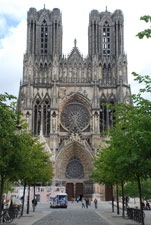New Connections appear every Wednesday. Sign up for a reminder.
Educator Nancy Wu has a deep connection with columns after spending years studying a Gothic cathedral.
 1280852
1280852 6851024
6851024 1280857
1280857 8511024
8511024 5411024
5411024 1280965
1280965 7221024
7221024 1280903
1280903 7221024
7221024 10241024
10241024 4051024
4051024 6911024
6911024 6491024
6491024 6711024
6711024 7451024
7451024 3481024
3481024 12801018
12801018 5511024
5511024 10241024
10241024 1280960
1280960 1280864
1280864 6281024
6281024 10241024
10241024 1280777
1280777 1280811
1280811 1280885
1280885 1280852
1280852
My name's Nancy Wu, I'm an educator at The Cloisters. I'm gonna talk about the column.
I spent many years working on Reims Cathedral. It is one of those huge Gothic cathedrals, full of tourists. It's not a building that you can study close up; you cannot hold it in your hand.
But you still have to study it carefully, in detail. My approach, which is not a common approach, is to measure the whole place. My base unit of my measurements is the column.
In a way, columns serve for me like the DNA of a person. I get into the habit of looking at the column by looking at the individual components
the capital, the shaft, the base. They are clues for me. If I see a fragment of a column
I can pretty much figure out the original height of that column. And I don't think it's unlike a pediatrician who has seen hundreds of babies.
So if you were to bring the pediatrician a baby, completely covered up revealing only the toe, I bet you the pediatrician
can tell just from the size of the toe the baby is probably three months old, six months old, nine months old. Really, that's the way I see columns.
The wonderful thing about this column is that most of the shaft is missing. The three components are compressed into a scale that is more visible for us, more of an eye-level.
And you get to see details that you cannot see if this column were in its original size. And the volutes, seen from one side, look like spirals, or even snails. My metaphors with architecture are very often food-related.
Spiral columns, the grooves, the patterns start to twist and to turn. It reminds me of a piece of dough, just freshly kneaded, and that the pastry chef is twisting it into some delicious dessert.
I know the shapes of columns, the proportions, have invoked associations with gender. Think of those beautiful women
depicted on vase paintings wearing these long robes with folds that are tubular. Don't they just look like the fluting of the columns?
So, chicken and egg question: what comes first, were artists inspired by the garment worn by the women around them, or the other way around?
What I'm envisioning is the owner of this dress, as if she was a column in motion, herself, as she parades through dinner parties. So I think a column is supposed to be supportive, solid, part of the architecture—all of these qualifications are broken.
My association is more architectural. I see them primarily as supporting devices. They can support
architecture, tables, little boxes. I'm always amazed by how this function can be kept
while the shape and form and the design of the column can vary so wildly.
I am Chinese. I'm embarrassed to admit I have never measured a Chinese building. I don't have the kind of DNA to have the visceral connection with this Chinese column.
The shafts tend to be a timber, cut from a tree, very simple, very unadorned, and I sort of instinctively like that.
The way I look at columns is pretty nerdy. The memories I have of measuring at Reims are the number of measuring tapes that I broke
the New Age music that was played from the souvenir stand, the candles.
So, when I look at columns outside of Reims, I smell the candles, I hear the music.
There are certain things that actually make me feel very warm
very personal. I feel as if I
I'm in possession of some of those columns
because I have spent so much time with them.
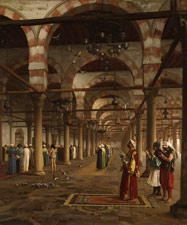 |
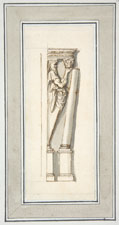 |
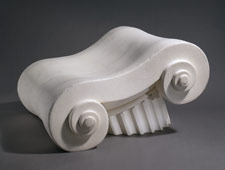 |
 |
 |
 |
 |
 |
 |
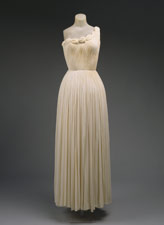 |
 |
 |
 |
 |
 |
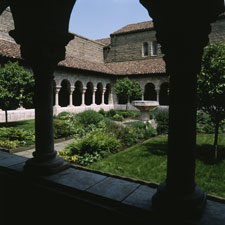 |
 |
Works of art in order of appearanceLast Updated: June 22, 2015. Not all works of art in the Museum's collection may be on view on a particular day. For the most accurate location information, please check this page on the day of your visit. |
||
 |
Prayer in the Mosque 1871 Jean-Léon Gérôme (French) Oil on canvas Signed (upper right, on beam): J.L. GEROME Catharine Lorillard Wolfe Collection, Bequest of Catharine Lorillard Wolfe, 1887 (87.15.130) More information: The Collection Online Not on view
|
 European PaintingsSecond Floor
European PaintingsSecond Floor |
 |
An Architectural Detail: A Herm Figure Placing or Removing a Column from Under an Entablature (after Stucco Frame by Daniele da Volterra from Orsini Chapel, Santa Trinita dei Monti) 18th century Anonymous (Italian) Pen and brown ink, brush and gray wash, over graphite The Elisha Whittelsey Collection, The Elisha Whittelsey Fund, 1948 (48.148(11)) More information: The Collection Online Not on view
|
 Drawings and PrintsSecond Floor
Drawings and PrintsSecond Floor |
 |
"Capitello" Chair 1971 Studio 65 (Italian); Gufram Self-skinning polyurethane foam Purchase, Friends of Twentieth Century Decorative Arts Gifts, by exchange, 2003 (2003.12a, b) © Gufram s.r.l. More information: The Collection Online Not on view
|
 Modern and Contemporary ArtSecond Floor
Modern and Contemporary ArtSecond Floor |
 |
Column surround with pensive woman Eastern Javanese period, 14th–15th century Indonesia (Java), Majapahit kingdom Terracotta Gift of Marie-Hélène and Guy Weill, in memory of William Wolff, 1992 (1992.151) More information: The Collection Online Not on view
|
 Medieval Art and The CloistersFirst Floor
Medieval Art and The CloistersFirst Floor
|
 |
Colosseum mid-16th century Italian school Published by Antonio Lafréri (French, active in Rome) From the Metropolitan Museum's copy of the Speculum Romanae magnificentiae (Mirror of Rome's Magnificence) Engraving Harris Brisbane Dick Fund, 1941 (41.72[1.59]) More information: The Collection Online Not on view
|
 Drawings and PrintsSecond Floor
Drawings and PrintsSecond Floor |
 |
Ionic capital, torus (foliated base), and parts of a fluted column shaft from the Temple of Artemis at Sardis 4th century b.c. Greek, Lydian Marble Gift of The American Society for the Excavation of Sardis, 1926 (26.59.1) More information: The Collection Online Not on view
|
 Greek and Roman ArtFirst Floor and Mezzanine
Greek and Roman ArtFirst Floor and Mezzanine |
 |
Column ca. 1400 Probably made in Veneto, Italy Limestone (Broccato Rosso di Verona) Gift of Myron and Anabel Taylor Foundation Inc., 1960 (60.116.2a–c) More information: The Collection Online Not on view
|
 Medieval Art and The CloistersFirst Floor
Medieval Art and The CloistersFirst Floor
|
 |
Large Figures on the North Porch, Chartres Cathedral 1852 Henri Le Secq (French) Salted paper print from paper negative Purchase, The Howard Gilman Foundation and Harriette and Noel Levine Gifts, Samuel J. Wagstaff Jr. Bequest, and Rogers Fund, 1990 (1990.1130) More information: The Collection Online Not on view
|
 PhotographsSecond Floor
PhotographsSecond Floor |
 |
Lekythos (oil flask) depicting Poseidon pursuing Amymone ca. 440 b.c.; Red-figure Attributed to the Phiale Painter Greek, Attic Terracotta Rogers Fund, 1917 (17.230.35) More information: The Collection Online Not on view
|
 Greek and Roman ArtFirst Floor and Mezzanine
Greek and Roman ArtFirst Floor and Mezzanine |
 |
Evening gown 1958 Madame Grès (Alix Barton) (French) White silk jersey Gift of Mrs. Leon L. Roos, 1973 (1973.104.2) More information: The Collection Online Not on view
|
 The Costume InstituteFirst Floor
The Costume InstituteFirst Floor |
 |
Housepost late 19th–early 20th century Auguena village, Santa Ana Island, Solomon Islands Wood Gift of Dr. Martin and Suzanne Schulman, 1986 (1986.486) More information: The Collection Online Not on view
|
 Arts of Africa, Oceania, and the AmericasFirst Floor
Arts of Africa, Oceania, and the AmericasFirst Floor |
 |
Pier Table 1810–15 Joseph B. Barry and Son (American) Northeast, Philadelphia, Pennsylvania Mahogany, mahogany veneer, satinwood, amboyna, pine, gilt bronze with yellow poplar Purchase, Friends of the American Wing Fund, Anonymous Gift, George M. Kaufman Gift, Sansbury- Mills Fund; Gifts of the Members of the Committee of the Bertha King Benkard Memorial Fund, Mrs. Russell Sage, Mrs. Frederick Wildman, F. Ethel Wickham, Edgar William and Bernice Chrysler Garbisch, and Mrs. F. M. Townsend, by exchange; and John Stewart Kennedy Fund and Bequests of Martha S. Tiedeman and W. Gedney Beatty, by exchange, 1976 (1976.324) More information: The Collection Online Not on view
|
 American Decorative ArtsFirst and Second Floors
American Decorative ArtsFirst and Second Floors |
 |
Bes on a column Late Period–Ptolemaic Period, 664–30 b.c. Egypt Bronze Gift of Miss Lily S. Place, 1921 (21.6.90) More information: The Collection Online Not on view
|
 Egyptian ArtFirst Floor
Egyptian ArtFirst Floor |
 |
Various Roman Ionic capitals compared with Greek examples, from Julien-David Le Roy's Les ruines des plus beaux monuments de la Grèce (1758): Plate 20 of Della magnificenza ed architettura de' romani 1761 Giovanni Battista Piranesi (Italian) Engraving Rogers Fund, 1941 (41.71.1.7.20) More information: The Collection Online Not on view
|
 Drawings and PrintsSecond Floor
Drawings and PrintsSecond Floor |
 |
Irregular Column 1984 John Duff (American) Fiberglass and enamel paint Purchase, Louis and Bessie Adler Foundation, Inc. Gift (Seymour M. Klein, President), 1985 (1985.179) More information: The Collection Online Not on view
|
 Modern and Contemporary ArtSecond Floor
Modern and Contemporary ArtSecond Floor |
 |
The Cuxa Cloister mid-12th century French or Spanish; From the Abbey of Saint-Michel-de-Cuxa (modern France) Marble The Cloisters Collection, 1925 (25.120.398,.399,.452) More information: The Collection Online Not on view
|

Medieval Art and The CloistersThe Cloisters at Fort Tryon Park |
 |
The Parthenon 1871 Frederic Edwin Church (American) Oil on canvas Bequest of Maria DeWitt Jesup, from the collection of her husband, Morris K. Jesup, 1914 (15.30.67) More information: The Collection Online Not on view
|
 American Paintings and SculptureFirst and Second Floors
American Paintings and SculptureFirst and Second Floors |
© 2011 The Metropolitan Museum of Art |
||

